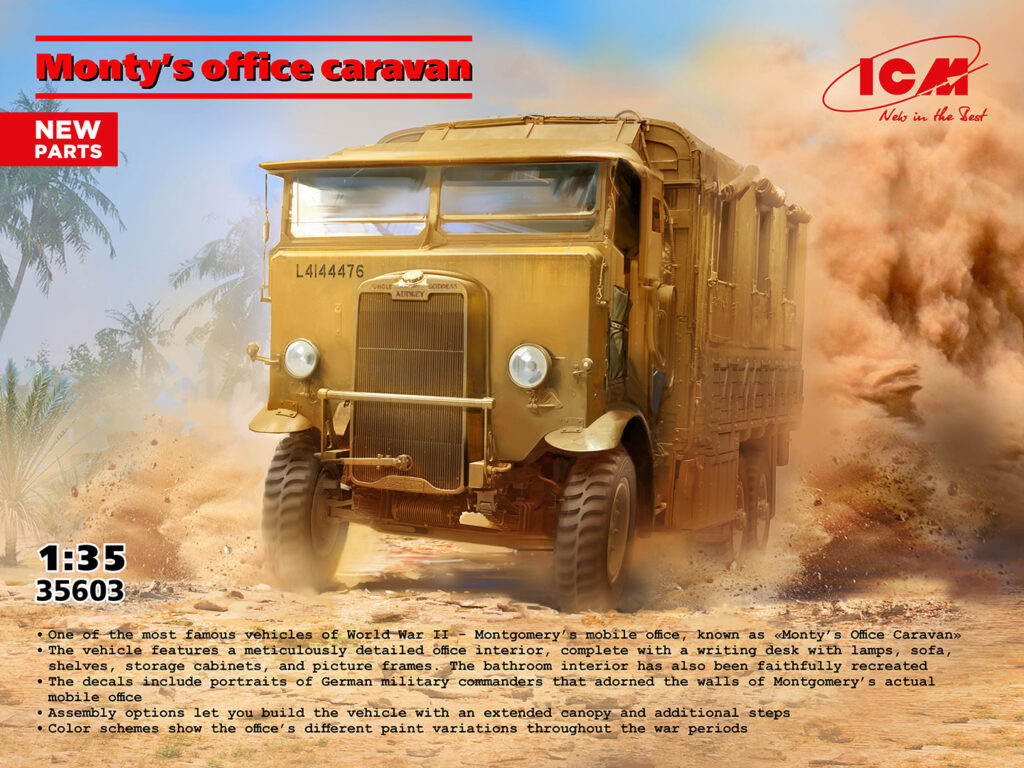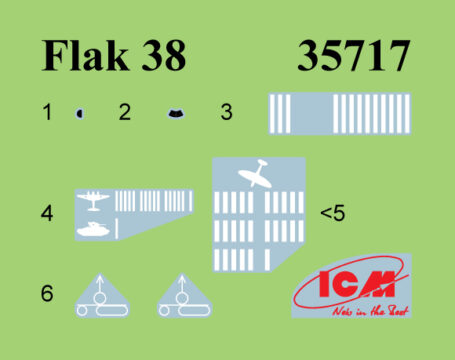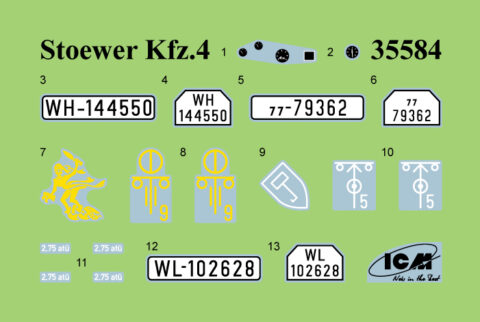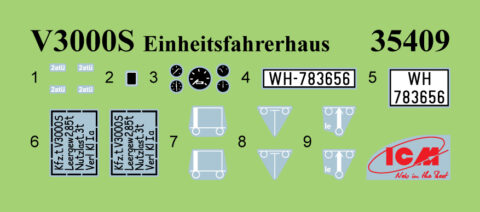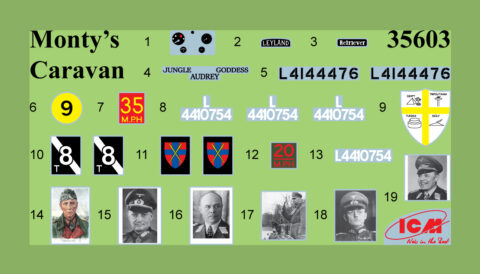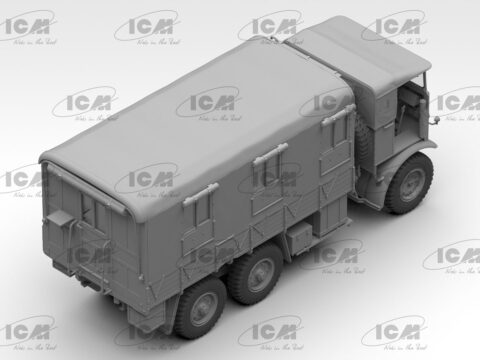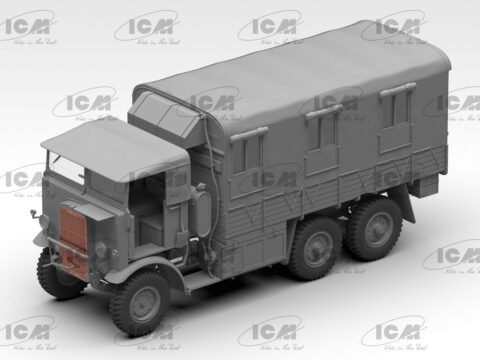Industry News
ICM News Mar 2025
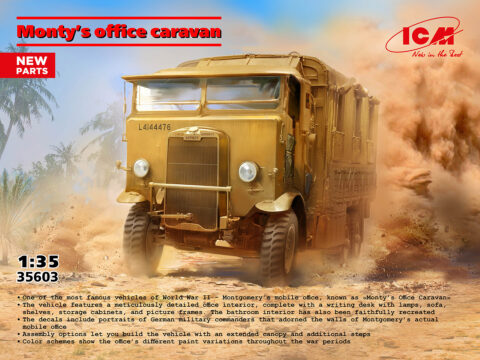
1/35 Monty’s office caravan
When General Montgomery commanded the 8th British Army in North Africa, he was provided with a specially designed staff vehicle. This original vehicle was created based on the standard British army vehicle, the Leyland Retriever. A non-standard structure was installed on the base chassis, which served as a mobile field office. The interior of the vehicle was divided into two rooms. The small front room was equipped with a bathroom, while the larger room contained wardrobes for personal belongings and clothes, a writing desk with desk lamps, and a large sofa.
Previously, this office belonged to the Italian General Bergonzoli and was mounted on a Lancia 3RO truck. After the vehicle was captured by a unit of the 7th British Armoured Division, the structure was transferred to the chassis of the British Leyland Retriever. After the end of the combat operations in North Africa, the mobile office was moved to Europe.
Montgomery also had two other specialized trucks: one was converted into a mobile bedroom, while the other was used for large staff maps and meetings. All three vehicles became known as “Monty’s Caravan.” These vehicles were used by General (and from 1944, Field Marshal) Montgomery until the end of the war. They are currently on display at the Imperial War Museum in Duxford.
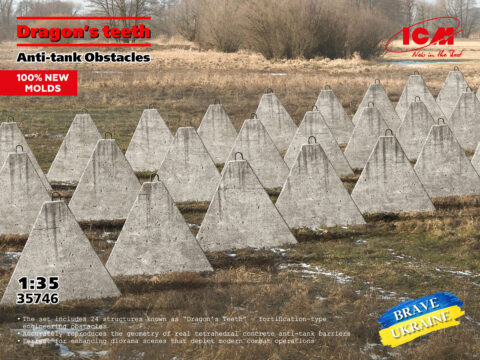
1/35 ’Dragon’s teeth’. Аnti-tank Obstacles
Concrete anti-tank obstacles, also known as ‘Dragon’s Teeth’, were first used during World War II. They are believed to have been invented in Finland as a means of defense against the armored vehicles of the Red Army. The purpose of these obstacles was not only to stop tanks and other armored vehicles but also to direct their movement into areas where they could be targeted by fire. These types of obstacles were widely used by all participants in the conflict, including neutral countries. For example, Switzerland also used similar obstacles, referring to them as Toblerone fortifications, due to their resemblance to the shape of the famous chocolate bars.
‘Dragon’s Teeth’ are still used today as engineering obstacles of a fortification type. Typically, they are made of concrete and have a tetrahedral shape, sometimes with the top corner cut off. A large number of such obstacles have been installed in Ukraine—both in areas where combat operations are taking place and in other regions of the country, as a protective measure in potentially dangerous zones
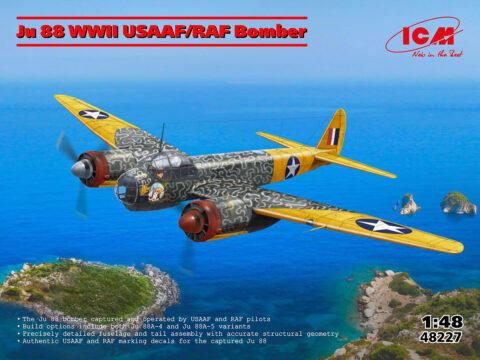
1/48 Ju 88 WWII USAAF/RAF Bomber
During World War I, the belligerent sides used enemy aircraft as fully functional combat units. In addition to purely combat use, the captured technology helped assess the technological development level of the enemy and identify its strengths and weaknesses. The same practice continued during World War II. Both the Allied and Axis powers extensively used captured enemy aircraft in their air forces.
For example, a Ju 88A-5 bomber from 2/KGr 106 of the Luftwaffe mistakenly landed in England on November 26, 1941. The aircraft was given British identification markings, a new camouflage, and the serial number HM509, and it flew as part of the RAF until May 1944.
Another interesting story involves a Ju 88A-4, captured by American forces in Italy in the fall of 1943. This bomber was incorporated into the 86th Fighter Squadron of the USAAF, where it received its original paint scheme and a bright emblem featuring an image of an Indian on the left side of the fuselage. Later, it was flown to the United States, where its appearance initially caused panic among air surveillance observers, as its silhouette was recognized as an enemy aircraft. The captured Ju 88A-4 was later stationed at several US Air Force bases and used in various public events.
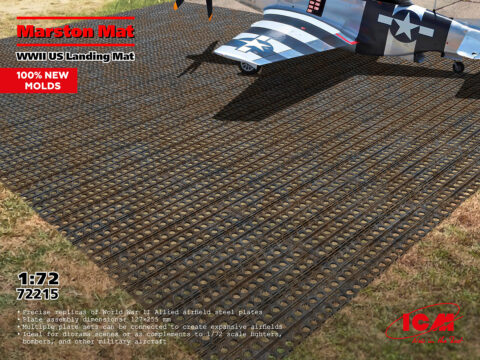
1/72 Marston Mat
WWII US Landing Mat
Marston Mat refers to special metal planks used during World War II for the rapid construction of temporary airfields. They were also known as PSP (Pierced Steel Planking). These planks were made of steel, could withstand heavy loads, and allowed for the installation of a stable and durable airfield surface for various types of aircraft on soft or unstable ground. The planks had a perforated design, which allowed water to drain easily without compromising the quality of the surface.
The Marston Mat was first used during maneuvers in North Carolina in November 1941, near Marston, which is where the name originated. Marston Mat was widely used in operations across the Pacific, North Africa, and Europe. With their help, engineering units of the U.S. Army and Navy were able to quickly construct airfields, for example, measuring 1500 by 45 meters, in just a few days. After the war, these planks were widely used for civilian purposes, including the construction of temporary roads and platforms.
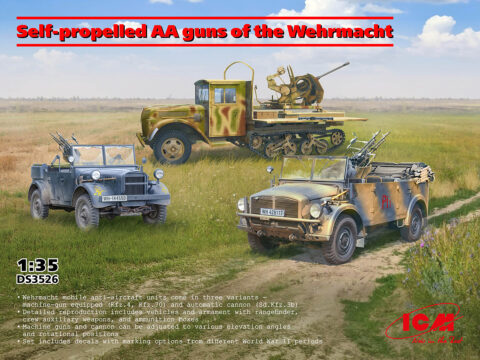
1/35 Wehrmacht Self-propelled AA vehicles
The first self-propelled anti-aircraft guns in the German army appeared during World War I. These were armored vehicles such as the Ehrhardt and Krupp-Daimler, equipped with 77mm guns. As aviation developed, mobile anti-aircraft guns played an even greater role in the air defense systems of ground units. During World War II, the Wehrmacht had a significant number of various self-propelled anti-aircraft installations, equipped with both paired machine guns and automatic cannons.
The vehicles often featured installations with paired 7.92mm MG 34 machine guns, designed to protect infantry from enemy aircraft. These installations were mounted on vehicles such as the le.gl.Einheits-Pkw or Horch. Automatic cannons, on the other hand, were mounted on various trucks, both wheeled and semi-tracked. One such vehicle was the semi-tracked version of the widely used V3000S cargo truck in the Wehrmacht, designated as Sd.Kfz.3b. In its bed, an automatic 2cm Flak 38 anti-aircraft gun was installed, and to allow for firing, either the sides of the vehicle were folded down or completely removed.
Self-propelled anti-aircraft guns were actively used on both the Western and Eastern fronts.
HobbyLink International
eBay Store

